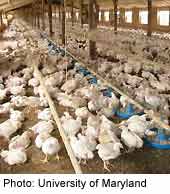
WEDNESDAY, Aug. 10 (HealthDay News) — Poultry farms that have made the transition from conventional to organic farming have significantly lower levels of antibiotic-resistant bacteria than conventional poultry farms, a new study finds.
Scientists are concerned about the use of antibiotics in farm animals because it has been shown to contribute to antibiotic-resistant bacteria that can spread to humans.
The researchers said they expected to see some differences in the farm levels of antibiotic-resistant enterococci when poultry farms transitioned to organic practices.
“But we were surprised to see that the differences were so significant across several different classes of antibiotics — even in the very first flock that was produced after the transition to organic standards,” study leader Amy Sapkota, an assistant professor with the Maryland Institute for Applied Environmental Health, said in a university news release. “It is very encouraging.”
The University of Maryland researchers tested 10 newly organic and 10 conventional poultry houses for the presence of enterococci bacteria in poultry litter, feed and water. Any enteroccoci bacteria found by the researchers was checked for resistance to 17 common antimicrobials.
“We chose to study enterococci because these microorganisms are found in all poultry, including poultry on both organic and conventional farms. The enterococci are also notable opportunistic pathogens in human patients staying in hospitals,” Sapkota said.
As expected, enterococci bacteria was found at all the farms. However, the organic farms had much lower levels of single and multiple antibiotic-resistant enterococci.
The study was published online Aug. 10 in the journal Environmental Health Perspectives.
“While we know that the dynamics of antibiotic resistance differ by bacterium and antibiotic, these findings show that, at least in the case of enterococci, we begin to reverse resistance on farms even among the first group of animals that are grown without antibiotics. Now we need to look forward and see what happens over five years, 10 years in time,” Sapkota said.
More information
The U.S. Food and Drug Administration has more about antibiotic resistance.

